Automotive Carbon Fiber Composites Market Size
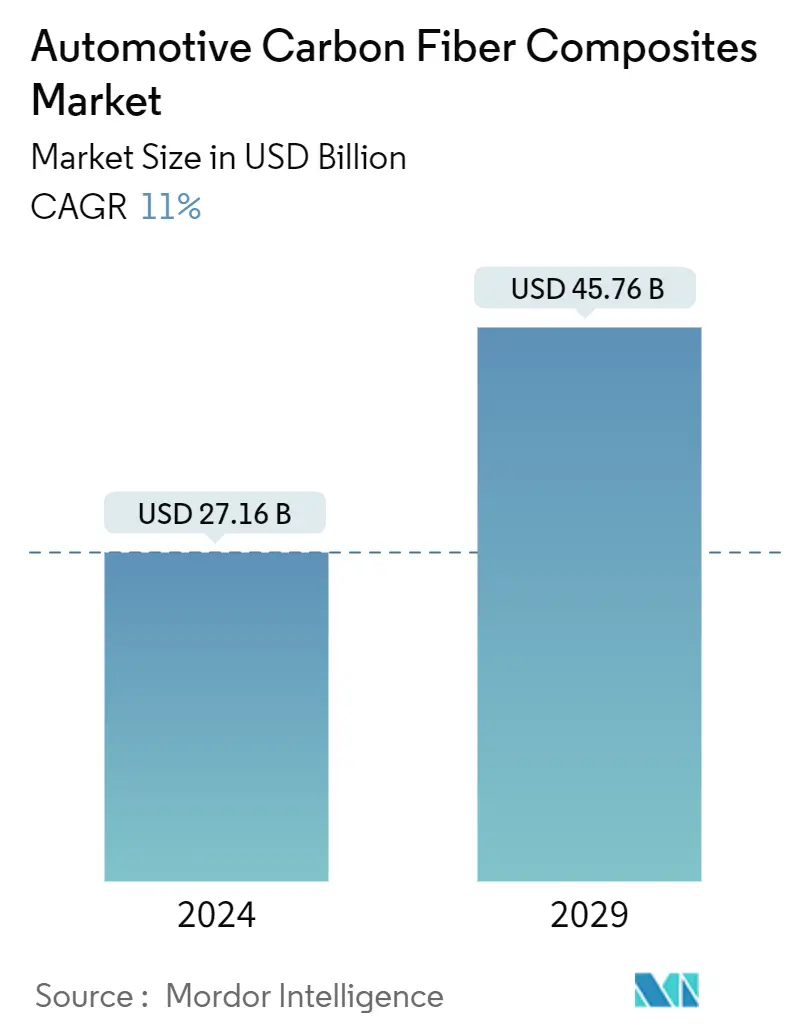
| Study Period | 2019 - 2029 |
| Market Size (2024) | USD 27.16 Billion |
| Market Size (2029) | USD 45.76 Billion |
| CAGR (2024 - 2029) | 11.00 % |
| Fastest Growing Market | Asia Pacific |
| Largest Market | Asia Pacific |
Major Players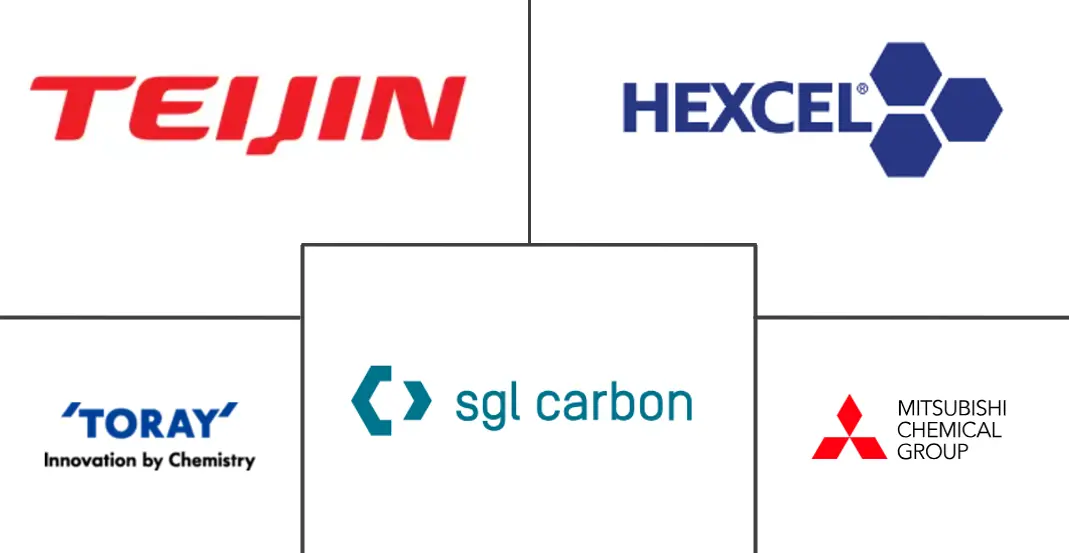
*Disclaimer: Major Players sorted in no particular order |
Automotive Carbon Fiber Composites Market Analysis
The Automotive Carbon Fiber Composites Market size is estimated at USD 27.16 billion in 2024, and is expected to reach USD 45.76 billion by 2029, growing at a CAGR of 11% during the forecast period (2024-2029).
Carbon fiber is a lightweight material with high-strength characteristics that can be designed for enhanced performance in automotive applications. It offers improvements in structural, functional, or cosmetic properties.
The rising demand for lightweight material from the automotive industry and the growing focus on fuel economy are expected to be major drivers for the automotive carbon fiber market. Amid increasingly stringent emission norms and rising fuel prices, carbon fiber is a great alternative to conventional metals as it can reduce the vehicle's weight. This can improve the fuel efficiency and performance of the engine while the fiber's physical strength limits are almost twice as high as those of conventional metals.
To make vehicles lighter, cleaner, safer, and cost-effective, leading carbon fiber suppliers are responding to the needs and expectations of vehicle OEMs, system suppliers, and customers. Major car companies, such as BMW, Audi, GM, Honda, and Polestar, have established agreements with carbon fiber material producers for mass production and are investing in their processes to support low-cost carbon fiber manufacturing.
- In June 2023, Dash-CAE launched a new carbon fiber monocoque chassis, the TR01, an affordable, versatile, and lightweight composite chassis for road cars. TR01 is suitable for any two-seat vehicle requiring a lightweight and stiff carbon fiber monocoque.
However, high costs associated with carbon fiber composites and glass fiber composites are hindering the market's growth, as their usage in low-cost vehicles could drastically increase the prices of such vehicles.
The rise in demand for electric vehicles worldwide is likely to enhance the penetration of carbon fiber to improve the range of electric vehicles, which, in turn, is likely to result in major growth for the market during the forecast period.
Automotive Carbon Fiber Composites Market Trends
The Passenger Car Segment Holds a Major Market Share
The rise in passenger vehicle sales has been in line with an increase in consumers' disposable incomes and buying capacities across the world. Further, the increase in vehicle electrification is likely to enhance the demand for lightweight vehicles, which is likely to result in major growth for the market during the forecast period.
Advanced materials such as carbon fiber are essential for boosting the fuel economy of modern cars and maintaining performance and safety. Since it takes less energy to accelerate a lighter object than a heavier one, lightweight materials offer great potential for optimizing vehicle efficiency and fuel economy. A 10% reduction in the vehicle's weight can transpire to a 6-8% increase in fuel economy. In a typical automobile, fiber is 50% by volume while adding 10% to the weight.
Due to the growing concerns over environmental issues caused by the rise in exhaust emissions, there has been an increasing demand for high-performance electric vehicles. This has been further supported by the introduction of strict regulations regarding emissions and fuel economy, as well as government initiatives such as subsidies and incentives to encourage the adoption of electric vehicles. For example, the UK government has already declared plans to cut 68% of CO2 emissions by 2030 in a proposal to tackle climate change and announced a ban on gasoline and diesel cars from 2030.
The rise in demand for electric vehicles owing to the enactment of stringent emission norms globally is likely to witness an increase in the integration of lightweight parts fabricated from composite materials.
Major players across the world are investing in R&D to bring in innovative carbon fiber components to enhance vehicle efficiency. For instance,
- In October 2023, Mitsubishi Chemical Group and Honda Motor Company jointly developed polymethyl methacrylate, an acrylic resin material for automotive body parts. The new material will be used in vehicle doors, hoods, fenders, and other automotive body parts.
Considering these aforementioned factors and developments, the demand for highly efficient carbon fiber in passenger cars is anticipated to register high growth during the forecast period.
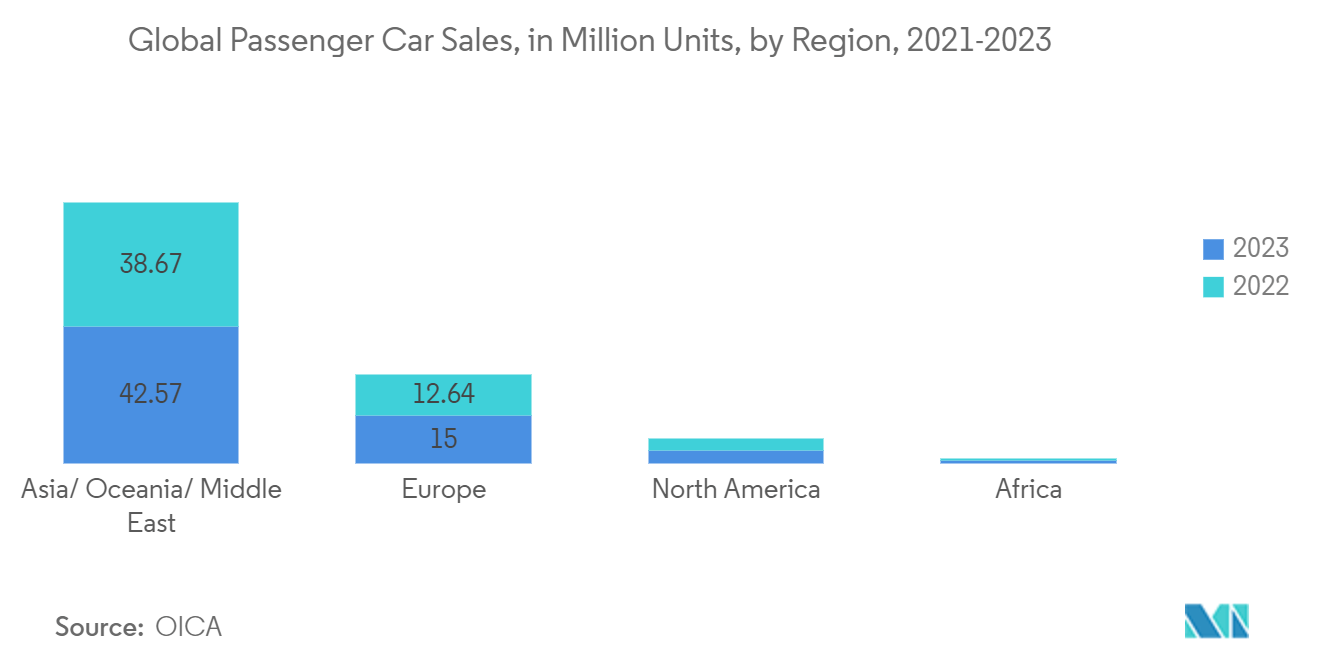
Asia-Pacific is Expected to Dominate the Market
Asia-Pacific is home to some of the world's largest automotive manufacturing countries, including China, Japan, India, and South Korea. In 2023, over 50 million units of motor vehicles were produced in Asia-Pacific, where China accounted for over 30 million units of vehicles, followed by Japan and India, respectively.
Many countries in Asia-Pacific have implemented stringent emissions regulations to combat air pollution and promote eco-friendly vehicles.
- In 2022, the China MEE EV Policy proposed a phase-out goal of a 50% share of EV sales for all vehicles by 2030 in "key polluting regions," indicating China's targeted approach to reducing vehicle emissions in areas most affected by air pollution.
These regulations have driven automakers to adopt lightweight materials like carbon fiber to reduce vehicle weight and improve fuel efficiency.
Moreover, several countries in Asia-Pacific, such as Japan and South Korea, have established a competitive advantage in the production and processing of carbon fiber. For example, Toray Industries, a Japanese company, is one of the world's largest producers of carbon fiber, with a global market share of over 30%. This strong manufacturing base has contributed to the growth of the automotive carbon fiber market in Asia-Pacific.
Thus, with the increasing focus on sustainable mobility, stringent emissions regulations, and the increasing demand for lightweight materials in the automotive industry, the Asia-Pacific is expected to dominate the automotive carbon fiber market during the forecast period.
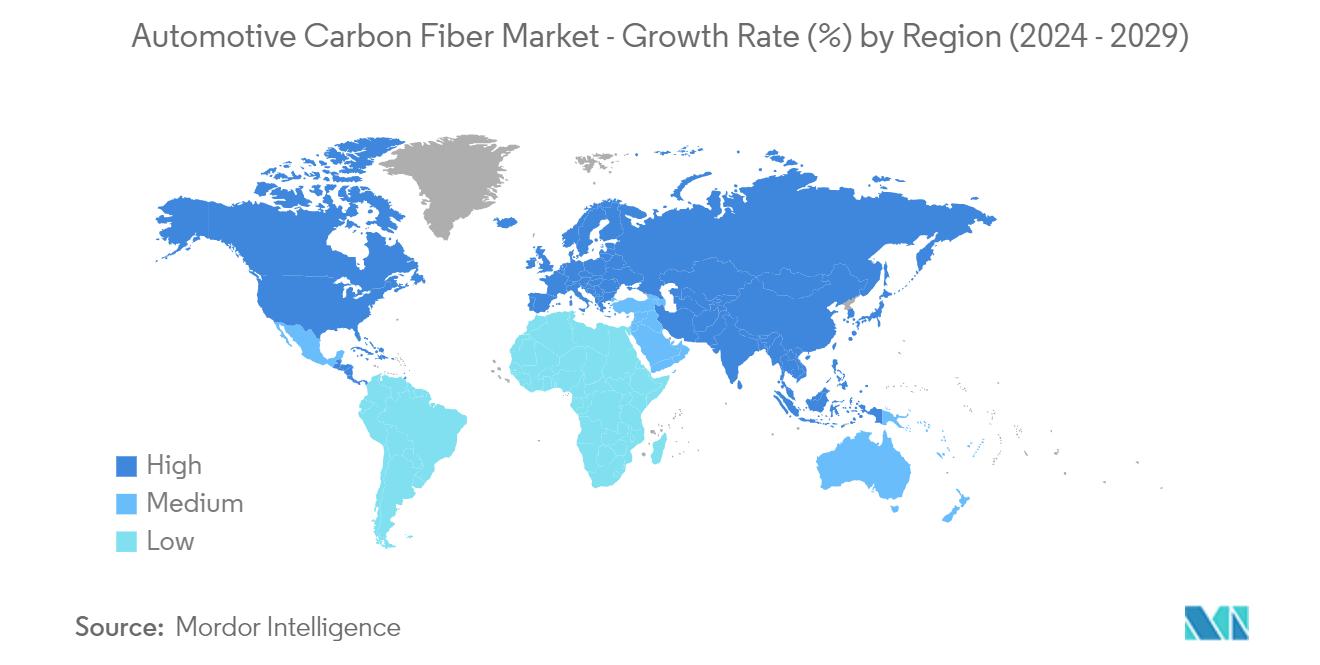
Automotive Carbon Fiber Industry Overview
The automotive carbon fiber market is moderately consolidated and is dominated by several key players, such as Hexcel Corporation, Mitsubishi Chemical Group, SGL Carbon SE, Teijin Limited, and Toray Industries Inc. The demand is on the positive side, attributed to strong expansion and growth strategies adopted by leading carbon fiber manufacturers. For instance,
- November 2023: Carbon Revolution, one of the leading carbon fiber companies in Australia, expanded its manufacturing facility in Mexico. Through this expansion, the company expanded its carbon-fiber wheel services across the country.
Automotive Carbon Fiber Market Leaders
-
Toray Industries Inc.
-
Hexcel Corporation
-
SGL Carbon SE
-
Teijin Limited
-
Mitsubishi Chemical Corporation.
*Disclaimer: Major Players sorted in no particular order
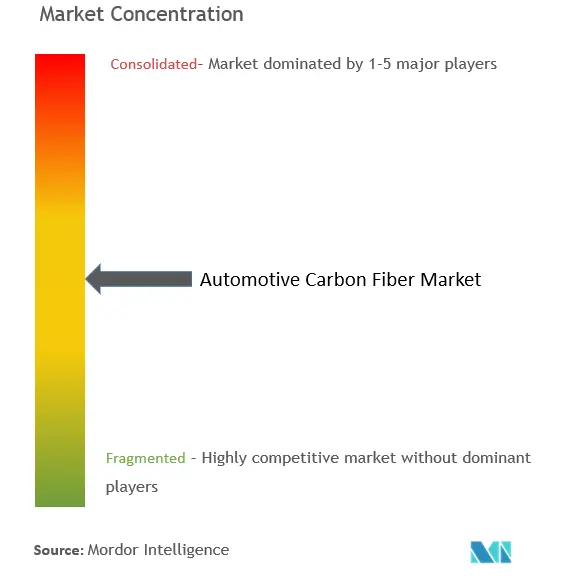
Automotive Carbon Fiber Market News
- April 2024: Hyundai Motor Group partnered strategically with Toray Industries to advance material innovation for new-era mobility. The partnership aims to develop lightweight, high-strength materials for environmentally friendly, high-performance vehicles that include carbon fiber-reinforced polymer (CFRP) parts.
- March 2024: The Mitsubishi Chemical Group (MCG Group) announced the development of a carbon fiber prepreg material, the BiOpreg #400 series, using plant-derived resin. The fiber is aimed at being used in mobility applications, such as interior and exterior materials for automobiles and industrial applications.
- December 2023: Teijin Limited announced plans to start producing and selling Tenax carbon fiber made from environmentally friendly materials. This material helps reduce greenhouse gas emissions during the product's life cycle.
- October 2023: Toray Industries Inc. developed TORAYCA T1200 carbon fiber, which boasts the highest strength of 1,160 kilopounds per square inch (Ksi). This advancement aids the company in reducing its environmental footprint by using lighter carbon-fiber-reinforced plastic materials.
Automotive Carbon Fiber Market Report - Table of Contents
1. INTRODUCTION
- 1.1 Study Assumptions
- 1.2 Scope of the Study
2. RESEARCH METHODOLOGY
3. EXECUTIVE SUMMARY
4. MARKET DYNAMICS
-
4.1 Market Drivers
- 4.1.1 Rising Demand for Lightweight Materials from the Automotive industry
-
4.2 Market Restraints
- 4.2.1 High Processing and Manufacturing Cost of Composites is a Challenge
-
4.3 Industry Attractiveness - Porter's Five Forces Analysis
- 4.3.1 Bargaining Power of Suppliers
- 4.3.2 Bargaining Power of Buyers/Consumers
- 4.3.3 Threat of New Entrants
- 4.3.4 Intensity of Competitive Rivalry
- 4.3.5 Threat of Substitute Products
5. MARKET SEGMENTATION (Market Size in Value- USD)
-
5.1 By Application
- 5.1.1 Structural Assembly
- 5.1.2 Powertrain Components
- 5.1.3 Interiors
- 5.1.4 Exteriors
-
5.2 By Vehicle Type
- 5.2.1 Passenger Car
- 5.2.2 Commercial Vehicle
-
5.3 By Propulsion
- 5.3.1 Internal Combustion Engine
- 5.3.2 Battery Electric Vehicles
- 5.3.3 Hybrid Electric Vehicles
- 5.3.4 Plug-in Hybrid Electric Vehicles
- 5.3.5 Fuel Cell Electric Vehicles
-
5.4 By Geography
- 5.4.1 North America
- 5.4.1.1 United States
- 5.4.1.2 Canada
- 5.4.1.3 Rest of North America
- 5.4.2 Europe
- 5.4.2.1 Germany
- 5.4.2.2 United Kingdom
- 5.4.2.3 France
- 5.4.2.4 Italy
- 5.4.2.5 Rest of Europe
- 5.4.3 Asia-Pacific
- 5.4.3.1 China
- 5.4.3.2 Japan
- 5.4.3.3 India
- 5.4.3.4 South Korea
- 5.4.3.5 Rest of Asia-Pacific
- 5.4.4 Rest of the World
- 5.4.4.1 South America
- 5.4.4.2 Middle East and Africa
6. COMPETITIVE LANDSCAPE
- 6.1 Vendor Market Share
-
6.2 Company Profiles*
- 6.2.1 Toray Industries Inc.
- 6.2.2 Hexcel Corporation
- 6.2.3 Mitsubishi Chemical Corporation
- 6.2.4 SGL Carbon SE
- 6.2.5 Teijin Ltd
- 6.2.6 BASF SE
- 6.2.7 Solvay SA
- 6.2.8 Bcomp Ltd
- 6.2.9 Dow Inc.
- 6.2.10 Nippon Sheet Glass Co. Ltd
- 6.2.11 BFG International Group
7. MARKET OPPORTUNITIES AND FUTURE TRENDS
- 7.1 The Increasing Demand for Electric Vehicles Presents Multiple Growth Opportunities
8. MARKET SIZE AND FORECAST IN TERMS OF VOLUME
** Subject To AvailablityAutomotive Carbon Fiber Composites Industry Segmentation
Carbon fiber is a lightweight material with high-strength characteristics that can be designed for enhanced performance in automotive applications.
The automotive carbon fiber market is segmented by application, vehicle type, propulsion, and geography. By application, the market is segmented into structural assembly, powertrain components, interiors, and exteriors. By vehicle type, the market is segmented into passenger cars and commercial vehicles. By propulsion, the market is segmented into internal combustion engines, battery electric vehicles, hybrid electric vehicles, plug-in hybrid electric vehicles, and fuel cell electric vehicles. By geography, the market is segmented into North America, Europe, Asia-Pacific, and Rest of the World. For each segment, the market sizing and forecast have been done based on the value (USD).
| By Application | Structural Assembly | |
| Powertrain Components | ||
| Interiors | ||
| Exteriors | ||
| By Vehicle Type | Passenger Car | |
| Commercial Vehicle | ||
| By Propulsion | Internal Combustion Engine | |
| Battery Electric Vehicles | ||
| Hybrid Electric Vehicles | ||
| Plug-in Hybrid Electric Vehicles | ||
| Fuel Cell Electric Vehicles | ||
| By Geography | North America | United States |
| Canada | ||
| Rest of North America | ||
| By Geography | Europe | Germany |
| United Kingdom | ||
| France | ||
| Italy | ||
| Rest of Europe | ||
| By Geography | Asia-Pacific | China |
| Japan | ||
| India | ||
| South Korea | ||
| Rest of Asia-Pacific | ||
| By Geography | Rest of the World | South America |
| Middle East and Africa |
Automotive Carbon Fiber Market Research FAQs
How big is the Automotive Carbon Fiber Composites Market?
The Automotive Carbon Fiber Composites Market size is expected to reach USD 27.16 billion in 2024 and grow at a CAGR of 11% to reach USD 45.76 billion by 2029.
What is the current Automotive Carbon Fiber Composites Market size?
In 2024, the Automotive Carbon Fiber Composites Market size is expected to reach USD 27.16 billion.
Who are the key players in Automotive Carbon Fiber Composites Market?
Toray Industries Inc., Hexcel Corporation, SGL Carbon SE, Teijin Limited and Mitsubishi Chemical Corporation. are the major companies operating in the Automotive Carbon Fiber Composites Market.
Which is the fastest growing region in Automotive Carbon Fiber Composites Market?
Asia Pacific is estimated to grow at the highest CAGR over the forecast period (2024-2029).
Which region has the biggest share in Automotive Carbon Fiber Composites Market?
In 2024, the Asia Pacific accounts for the largest market share in Automotive Carbon Fiber Composites Market.
What years does this Automotive Carbon Fiber Composites Market cover, and what was the market size in 2023?
In 2023, the Automotive Carbon Fiber Composites Market size was estimated at USD 24.17 billion. The report covers the Automotive Carbon Fiber Composites Market historical market size for years: 2019, 2020, 2021, 2022 and 2023. The report also forecasts the Automotive Carbon Fiber Composites Market size for years: 2024, 2025, 2026, 2027, 2028 and 2029.
Carbon Fiber in Automotive Industry Report
Statistics for the 2024 Carbon Fiber in Automotive market share, size and revenue growth rate, created by Mordor Intelligence™ Industry Reports. Carbon Fiber in Automotive analysis includes a market forecast outlook to 2029 and historical overview. Get a sample of this industry analysis as a free report PDF download.



